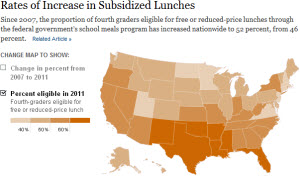School or lunch counter?

This handy map at the New York Times shows the percentage of schoolchildren eligible for free or reduced-price lunches at school by state in 2011.
In Michigan, almost half the children are eligible -- 45 percent. And, sadly, that's a good figure, by national standards. Twenty-two states have a majority of schoolchildren qualified. In parts of the deep South and Southwest, two-thirds of schoolchildren are eligible for federal help for routine meals.
When we decided to take on our State Academic Championships project at Bridge, one key issue for us was to compare school districts against those with comparable student populations. We used the percentage of the student body receiving free (but not reduced-price) lunches to group the schools into divisions. (For more on the the methodology, click here and scroll to bottom of article.)
A point often lost, I think, in the discussion of school performance is the wide variety of duties and challenges we assign school districts. Our educational system wasn't really designed to deal with student nutrition, much less provide subsidized access to meals. Yet, in the 21st century, it passes without much remark that public schools are expected to manage a food service and its associated accounting requirements.
They also are expected to properly educate children who may not be coming to school ready to learn.
The free and reduced-price lunch program muddles this issue a bit because of its eligibility rules. There are some children in this nation who are most likely going hungry in the classical sense of the term, despite all of the public and private efforts to defeat hunger. That's on the extreme margin, though.
A child out of a four-person household qualifies for reduced-price lunches with a family income of up to $41,000. The same child would quality for free lunches if the family income was below $29,000.
The 45 percent of children in Michigan or 64 percent in Texas would not starve without food services in public schools. But, as a society, we have chosen to raise the bar a bit on nutrition and use public resources to help those struggling, for whatever reason, to help themselves. (There also was the little matter of helping out farmers who were worried about prices for the products.)
But what makes a public school intrinsically well-equipped to handle this duty? It was assigned to schools not because they have expertise in food service or accounting or discerning the intent of bureaucrats who write federal reporting requirements (or the members of Congress who stand behind them). If the goal is to get food to needy families, why not bolster the food stamp program so that families can purchase food to send with their children via the ol' brown bag?
No one really questions why schools are charged with this job, yet they are expected to do it well -- and while they are doing well on that other little duty: education.
There is plenty of room for reform in public education. But it would be helpful to the cause of actual reform if parents and voters and legislators would step back for a minute and consider all that is expected of school districts now -- and whether such expectations might have something to do with the current results.
See what new members are saying about why they donated to Bridge Michigan:
- “In order for this information to be accurate and unbiased it must be underwritten by its readers, not by special interests.” - Larry S.
- “Not many other media sources report on the topics Bridge does.” - Susan B.
- “Your journalism is outstanding and rare these days.” - Mark S.
If you want to ensure the future of nonpartisan, nonprofit Michigan journalism, please become a member today. You, too, will be asked why you donated and maybe we'll feature your quote next time!
